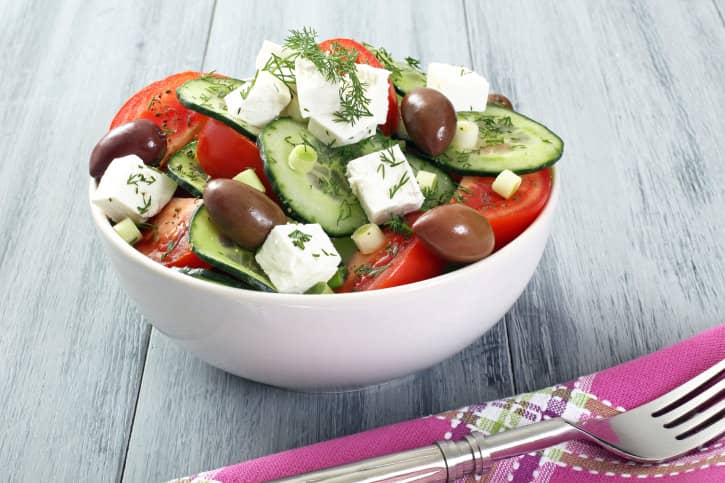Have you ever noticed that no matter where you are, there seems to be a different version of Greek salad dressing out there? For those of us living in the United States, for example, differences in Greek dressing can be very confusing. When ordering a Greek salad at a local restaurant, it could look much different than a salad that was ordered in Greece. Americans seem to expect that their Greek salads have a creamy dressing that often has a buttermilk or yogurt base. The differences between the salad dressings largely have to do with the types of salads that can be found.
Greek Village Salad
 When you order a traditional salad in Greece, it usually contains cucumbers, tomatoes, bell peppers, and onions. Traditional Greek olive oil is then ladled over the vegetables and a generous helping of fresh or dried herbs, such as oregano, are then sprinkled at the top. The vegetables are also sprinkled at sea salt, which adds another dimension of flavor.
When you order a traditional salad in Greece, it usually contains cucumbers, tomatoes, bell peppers, and onions. Traditional Greek olive oil is then ladled over the vegetables and a generous helping of fresh or dried herbs, such as oregano, are then sprinkled at the top. The vegetables are also sprinkled at sea salt, which adds another dimension of flavor.
Optionally, the salad could be drizzled with whatever vinegar the chef has on hand. In the United States, this salad is called a “Greek Village Salad”. In Greece, it’s referred to as “Horiatiki”. However, if you simply order “salad” in Greece, Chances are pretty good that this is what you’ll end up with. Here’s a recipe to follow if you want to make this at home!
Greek-Inspired Salads
When ordering a Greek salad in the United States, it’s designed to satisfy not only the American palate, but they also use the vegetables that are readily available. In Greece, it’s fairly uncommon to find a salad that is piled high with lettuce. Since lettuce typically needs cooler temperatures and a lot of water, it doesn’t typically grow well in the hot, arid Greek climate. If salads in Greece do contain lettuce, there’s very little of it since it isn’t all that common.
The salad dressing is unique, too, since it could be cream based (but it doesn’t have to be). Most Greek dressings in the United States either use buttermilk or yogurt. Aside from appealing to the desires of American eaters, it’s unclear as to why these salad dressings actually exist. Some companies do blend in traditional ingredients such as feta cheese in their American-style Greek dressings, but that still doesn’t make it traditional.
Oil and Vinegar Dressing

Greeks do enjoy traditional vinaigrette made with either oil and lemon or oil and vinegar. These dressings are used for more than just dressing fresh vegetables, though. For example, olive oil and lemon is often used to dress steamed greens, artichokes, and even meats. Chicken or lamb souvlaki, for example, is marinated in a mixture of lemon juice, olive oil, garlic, and other herbs and spices. A similar dressing is brushed on meats like roasted chicken before baking.
Oil and vinegar, however, is one of the most popular fresh salad dressings in Greece. Since the olive oil is so fresh, however, there is a higher proportion of olive oil than vinegar. In fact, most Greeks don’t bother making a vinaigrette in a separate bowl. They just toss all the ingredients in at once with the salad. Somehow, it always comes out perfectly.


